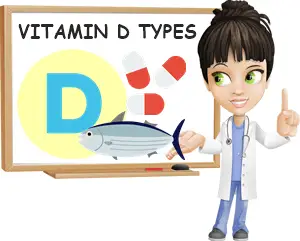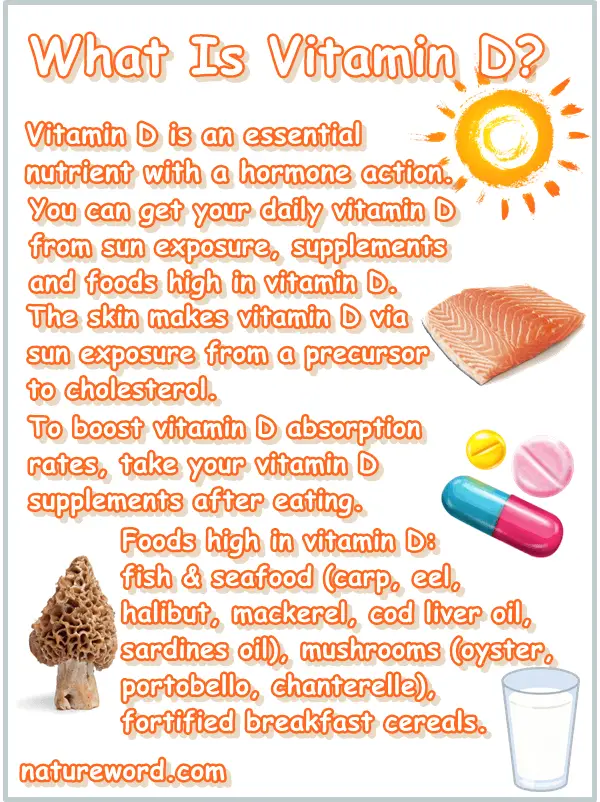Vitamin D is the only essential nutrient that can be produced entirely by the human body if missing from the diet. In fact, foods that contain vitamin D naturally often do not provide enough of it to meet daily requirements, every day, when consumed in what is largely regarded as a normal amount. Not to mention that only some classes of foods have vitamin D which means that not all diets are sources of the nutrient.
What is vitamin D?
Vitamin D is officially classified as an essential nutrient, meaning the human body absolutely needs it. For a long time now, it has been referred to as a ‘vitamin’, and still is. However, emerging voices are calling for it to no longer be called a vitamin, but rather a hormone, which it also is based on its functions in the human body and known pathways of action.

From a nutritional standpoint, vitamin D is an essential nutrient, or a nutrient that is absolutely needed by the human body. Currently, it’s also classified as an essential, fat soluble vitamin. Chemically, vitamin D is a steroid, simply a type of naturally occurring or organic compound with a specific makeup. This also makes it a hormone.
Types of vitamin D
There are 5 known forms of vitamin D, some that are biologically active and some that are not.
Vitamin D3:
Vitamin D3 is the form of vitamin D produced in the skin as a result of sun exposure. It is also called cholecalciferol and colecalciferol (official names). The skin makes vitamin D3 from a cholesterol precursor called 7-Dehydrocholesterol, in response to exposure to UV radiation from sunlight, or artificial UV light. 7-Dehydrocholesterol is a type of organic compound known as a sterol, and it’s of animal origin.
Vitamin D3 also occurs naturally in some foods. Examples of foods that have vitamin D3 naturally: animal foods such as fish, fish liver oils, some seafood, beef liver, milk, cheese and other dairy.
See my list of fish high in vitamin D.
Other plant and animal foods may have vitamin D3 added to them via fortification, especially flour and byproducts (breakfast cereals, cakes, biscuits, cookies etc.), but also plant milks and plant-based beverages. Vitamin D3 is also a form of vitamin D available as a nutritional supplement for preventing and reversing vitamin D deficiency.
Vitamin D3 is initially biologically inert. What this means is that it exerts no effects in the body as it is. However, it is successively processed by the liver and kidneys and rendered active, becoming a source of major benefits for health. The liver turns vitamin D3, aka cholecalciferol, into a form called calcifediol (25-hydroxyvitamin D) which then goes to the kidneys which turn it into a form called calcitriol (1,25-dihydroxyvitamin D). The latter form, calcitriol (1,25-dihydroxyvitamin D), is the biologically active form of vitamin D, essentially a hormone.

Vitamin D2:
Vitamin D2 is a form of vitamin D from food. That is, it is present naturally in some foods. It is also called ergocalciferol and calciferol. Vitamin D2 is also available as a nutritional supplement for preventing and reversing vitamin D deficiency, and used to fortify various foods.
Vitamin D2 is made from ergosterol, a type of organic compound known as a sterol, and it’s of plant origin. Ergosterol is like a plant form of cholesterol. Ergosterol is also classified as a type of provitamin D because vitamin D2 is made from it.
Vitamin D2 production is triggered by exposure to UV (ultraviolet) radiation, just like vitamin D3 production in the skin. Mushrooms, various yeasts, and other fungi and organisms, contain ergosterol and produce vitamin D2 naturally when exposed to UV radiation from either sunlight or man-made UV lights.
Vitamin D supplements that contain the form colloquially called vitamin D2 are typically made from fungi such as various species of mushrooms. Select species of mushrooms are grown at an industrial scale in order to extract ergosterol, the vitamin D2 precursor, also called a provitamin D2. Following extraction, the provitamin is exposed to UV (ultraviolet) radiation to trigger conversion to ergocalciferol or vitamin D2.
Vitamin D1:
Vitamin D1 is a blend of ergocalciferol (vitamin D2) and lumisterol (a natural compound with the same chemical formula as the provitamin D2 form ergosterol, but a different shape).
Vitamin D4:
Vitamin D4 is officially called 22-Dihydroergocalciferol. It is a form of vitamin D that is present naturally in some mushroom species and other fungi. You can find vitamin D4 in common foods such as such as:
- Champignon or portobello mushrooms (Agaricus bisporus), both white and brown varieties.
Note: Find out what is the difference between portobello, portabella, cremini and button mushrooms. - Field mushrooms or meadow mushrooms (Agaricus campestris).
- Tree oyster mushrooms or simply oyster mushrooms (Pleurotus).
- Chanterelle mushrooms, or chanterelles.
- Maitake mushrooms, also known as sheep’s head or ram’s head mushrooms, or hen-of-the-woods mushrooms (Grifola frondosa).
- Morels, or morel mushrooms (Morchella). Study.
Vitamin D4 is produced in mushrooms from a plant form of cholesterol via exposure to UV radiation from natural sunlight, or via exposure to artificial UV lights. What this means is that commercially grown mushrooms may have an equally good or even higher content of vitamin D4 as naturally sourced mushrooms.
Vitamin D5:
Officially known as sitocalciferol, vitamin D5 is produced from 7-Dehydrositosterol via sun exposure. 7-Dehydrositosterol is a precursor to vitamin D5, and a compound that occurs naturally in some foods. Exposure to UV radiation from sunlight triggers its conversion into vitamin D5. Vitamin D5 is currently under investigation for its anticancer potential and studied as a potential treatment for prostate cancer Antitumor effects of vitamin D5: apoptotic and antiproliferative action.
Where do you get your daily vitamin D from?
There are three ways to get your daily vitamin D: sun exposure, dietary supplements and specific foods.
Sun exposure
An average of 15 to 20 minutes of sun exposure per day is generally considered enough to meet your daily requirements of the vitamin. Only the face, neck and arms may be exposed to sunlight to produce all the vitamin D you need in a day.
Dietary supplements
Dietary supplements containing either vitamin D2 or vitamin D3 are good options for meeting daily vitamin D requirements. A vitamin D supplement is recommended when sunlight exposure is not an option, or when your vitamin D levels are too low, for correcting a deficiency.
Vitamin D supplements are especially good for babies and small children to help with normal bone development and teeth health, and recommended for anyone with low immunity and, more recently, fertility issues. Vitamin D is also a source of benefits for mental health and can help regulate sleep. For better bone density, vitamin D supplements are combined with calcium and magnesium supplements.
Foods high in vitamin D
If you were to try and get most of your daily vitamin D from dietary sources, then know that certain foods, and certain classes of foods, are the way to go. The best sources of vitamin D are fish and seafood such as halibut, carp, mackerel, farmed rainbow trout, eel, cod liver oil and sardines oil, but also tuna and salmon.
Beef liver, eggs, whole milk, fatty cheeses also have a modest to good content of vitamin D. Mushrooms, especially mushrooms from commercial production (grown using UV light) such as champignons or portobellos, are also good foods to get your vitamin D from.
Vitamin D is virtually non-existent in plant foods, except for mushrooms. While it does not occur naturally in most plant foods, lots of common, plant-based foods are fortified with it. Breakfast cereal, especially kids cereals, but also most flour-based foodstuff, bread, breakfast cookies or biscuits, meal replacement options such as protein bars, high-protein beverages, nut milk and plant-based beverages, especially soy-based, and even regular milk are typically fortified with vitamin D.
